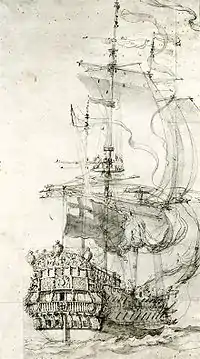HMS Mordaunt
HMS Mordaunt was a 46-gun ship of the line of the Royal Navy, launched at Deptford in 1681 and in active service during the Nine Years' War with France. After extensive service in both European and Caribbean waters, Mordaunt foundered off the coast of Cuba on 21 November 1693.
 Drawing of Mordaunt by Willem van de Velde the Elder | |
| History | |
|---|---|
| Name: | Mordaunt |
| Builder: | William Castle, Deptford |
| Launched: | 1681 |
| Acquired: | 7 October 1682 |
| Commissioned: | 20 May 1684 |
| In service: | 1684–1693 |
| Fate: | Sank off Cuba, 21 November 1693 |
| General characteristics | |
| Class and type: | 46-gun ship of the line |
| Tons burthen: | 567 26⁄94 (bm) |
| Length: |
|
| Beam: | 32 ft 4.5 in (9.9 m) |
| Depth of hold: | 13 ft 0 in (4.0 m) |
| Sail plan: | Full-rigged ship |
| Complement: | 230 at commissioning |
| Armament: |
|
Construction
Plans for the vessel's construction were developed in the late 1670s by a private syndicate headed by Charles Mordaunt, 3rd Earl of Peterborough, with the publicised intention that she be used solely as a merchantman. A contract for her construction was issued in 1680 to William Castle, a commercial shipwright at Deptford, initially on behalf of the syndicate and then solely in the name of Charles Mordaunt. Castle set to work immediately, and construction proceeded apace. As built, the new ship was 122 ft 6 in (37.3 m) long with a 101 ft 9 in (31.0 m) keel, a beam of 32 ft 4.5 in (9.868 m), and a hold depth of 13 ft 0 in (4.0 m).[1] She was a large vessel, measuring 567 26⁄94 tons burthen. Castle included a total of 56 gun ports in Mordaunt's design but several were too constrained by internal fittings to house a gun, and in practice the vessel was not capable of carrying more than 48 cannons.[2]
The vessel's stern featured a carved crest displaying the Mordaunt family coat of arms: a chevron beneath three stars.[2]
Civilian career
Even with 48 guns, Mordaunt would be very heavily armed for a merchant craft, and there were public rumours that she was actually intended as a private warship. In early 1681 Spain's Ambassador to England wrote to Admiralty expressing his fear that the vessel would be sold to the Elector of Brandenburg, who was assembling a fleet to prey on Spanish shipping. Admiralty responded by issuing a warrant on 30 June 1681 for the seizing of the vessel, accompanied by a request that Mordaunt attend the Admiralty Court to explain his intentions in having her constructed. In advance of the hearing, Admiralty itself advised the court that Mordaunt was "built frigate-fashion and is as good a ship as His Majesty's ship [the 48-gun] Tyger." Charles Mordaunt appeared before the court in July to attest that the vessel was indeed a merchantman, and that the heavy armament was simply to enable her to sail without convoy protection. The Court resolved to return the vessel to Mordaunt but obliged him to guarantee that she would not be used for military purposes.[2]
The vessel was completed in 1681, and a crew of 200 were hired and brought aboard. Problems then arose with their pay, with the ship's company lodging a civil action for non-payment of wages in 1682. Admiralty again seized the vessel while this claim was being heard, but simultaneously entered negotiations for her purchase.[2] The sale was completed on 7 October 1682 with the vessel entering Navy service as HMS Mordaunt.[1] Her crew were offered a transfer into naval service to accompany their ship, and most agreed; the civil claim was settled in their favour in May 1683 but the outstanding wages were never subsequently paid.[2]
Naval career
The newly purchased vessel was sailed to Deptford Dockyard in late 1682, for fitting out as a Royal Navy ship of the line. She remained at Deptford throughout 1683, finally being commissioned into active service on 20 May 1684 under the command of Captain Henry Killigrew. The War of the Reunions had broken out in Europe, but Britain was at least temporarily at peace and Mordaunt was sent to cruise along the coastline of West Africa as protection for Britain's regional British merchant and slave-trading interests. She returned to England in 1685, where she remained for the next two years. Killigrew left the vessel in 1687, with command transferring to Captain John Ashby.[1]
Notes
- Winfield 2009, p. 140
- Robinson, Gregory; Anderson, R.C. (1912). "The Identification of Models of Men-Of-War". The Mariner's Mirror. Portsmouth, United Kingdom: Society for Nautical Research. 2 (6): 163–166. doi:10.1080/00253359.1912.10654603.
References
- Winfield, Rif (2009). British Warships of the Age of Sail, 1603–1714: Design, Construction, Careers and Fates. Seaforth. ISBN 9781848320406.